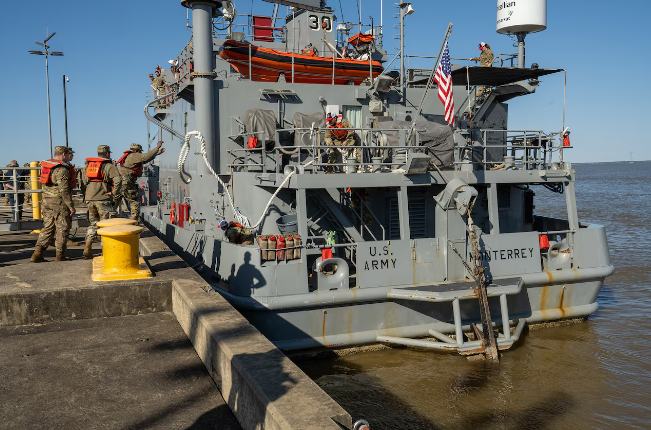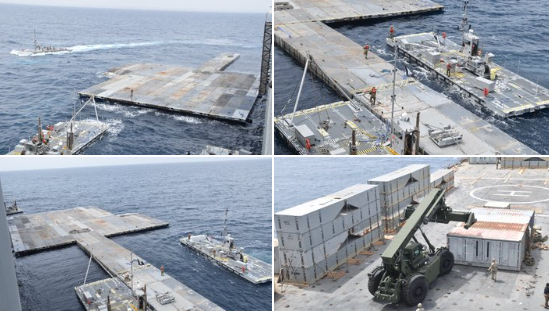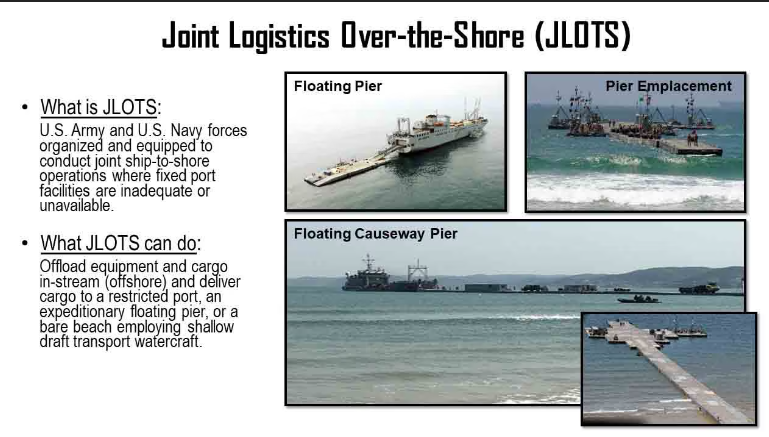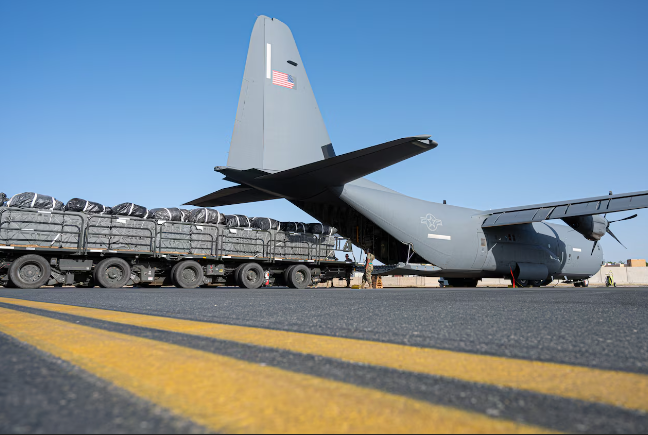
UPDATE:
U.S. Central Command released the photos below of the ongoing construction of the floating JLOTS pier in the Mediterranean.

Original Post:
Today, Secretary Antony Blinken will travel to Saudi Arabia, Jordan, and Israel to meet with regional partners. One of the subjects on the table is the increase of humanitarian aid to Gaza and “the importance of ensuring that increase is sustained.”
The U.S. JLOTS project will certainly be discussed.
During his March 7 State of the Union Address, President Biden announced an ambitious project that will significantly boost the amount of desperately needed humanitarian aid to the people of Gaza.
The project, known as Joint Logistics-Over-the-Shore, or JLOTS, will consist of a floating dock about three miles off the Gaza shore, a floating pier attached to an approximately 1,800-foot-long modular causeway anchored to the shore and, finally, a group of logistic support vessels (LSVs) that will transport the aid from the dock to the pier/causeway (below).

About 1,000 soldiers and sailors and at least 14 U.S. ships are engaged in the project.
Once fully operational, JLOTS will permit the delivery of up to 2,000,000 meals per-day for Gaza’s 2.3 million people, starting with an estimated daily transport of 90 truckloads, eventually ramping up to 150 truckloads when the pier-causeway is fully operational.
In close cooperation with the U.S. Agency for International Development, the World Health Organization, aid providers, Israeli representatives and other agencies, the aid will be inspected and loaded at Larnaca, Cyprus, onboard commercial ships and then transported to the floating dock, a journey that normally takes about 15 hours.
Once at the dock, the aid will be offloaded onto U.S. Army LSVs and taken to the floating pier where trucks from a “third country” will transport the aid over the causeway to distribution centers run by the United Nations and others.
With one week left to the deadline, it seems that the U.S. military will meet the ambitious schedule.
A “Senior Military Official” at an April 25 DoD background briefing provided the latest status. “Earlier today, the at-sea assembly of key pieces of the temporary pier began off the coast of Gaza. We are on track to begin delivery of humanitarian assistance to Gaza from the sea in early May,” he said.
The official concluded:
I’ll leave you with just three thoughts. Big picture. The U.S. military is building up and building a maritime pier to surge global aid. We have developed a comprehensive, integrated security plan with the Israeli Defense Forces to address force protection of American troops. And everything is in place: the people, procedures, ships and coordination protocols. Our plan to deliver lifesaving aid from the sea is on track for delivery in early May.
However, JLOTS has not been without challenges, concerns, even danger.
Concerns have been voiced about the risk the mission brings to U.S. personnel as they will be “working near active fighting between Israel Defense Forces and Hamas militants,” and, more to the point, about having U.S. boots on the ground in a conflict zone.
Both the White House and DoD have underscored that no U.S. troops will be on land for the work and have assured that protecting U.S. troops is of top priority.
According to DoD, the U.S. “has coordinated with the Israeli Defense Force to provide force protection for U.S. personnel operating at sea… [and with] an IDF engineering unit to receive the pier on the shore in Gaza once the construction at sea is complete.”
A more recent (unconfirmed) report by the BBC states that “the British government is considering deploying troops to drive the trucks that will carry aid from the pier along a floating causeway to the shore.”
A little more than two weeks ago, the U.S. Navy’s cargo ship 2nd Lt. John P. Bobo, one of three navy vessels involved in JLOTS, suffered a fire in the engine room while on its way to the Mediterranean and had to return to Jacksonville, Florida.
According to the U.S. Navy, “All ship’s crew and military personnel are accounted for, and no injuries were reported.” The Navy added, “It’s not going to impact any timeline of JLOTS standing up,”
Raising concerns about the risk to American troops, on April 25 unidentified Gaza-based militants launched mortar rounds towards the area where the causeway will be attached to the shore. No US troops were in the area, no American equipment was damaged and fortunately no one was injured.
On Thursday, Gen. Ryder, said the attack ”in no way delays” completion of the project.
It may be a coincidence that “less than a day after the Pentagon confirmed [the] mortar attack, the U.S. Navy announced that the Dwight D. Eisenhower Carrier Strike Group arrived in the eastern Mediterranean Sea on Friday…”
In the meantime U.S. Air Force C-130Js, along with other partner nations aircraft, continue to airdrop humanitarian assistance over Gaza. “To date the U.S. has dropped more than 1082 tons of humanitarian assistance.” in more than 25 missions.

















